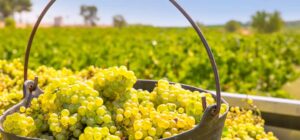California Chardonnay
This month, we’ll talk about and taste chardonnay, one of the most well-known and dominant grape varieties in the world. There are so many countries that produce chardonnay, one could spend months exploring all that this wonderful grape has to offer. I decided to feature California chardonnay for this post and to focus on three major growing areas: the Russian River Valley, Napa Valley, and the Central Coast.
Chardonnay is believed to have originated in the Burgundy region of France. Cuttings were brought to the United States in the late 1800s and by the late 1970s, approximately 7,000 acres of chardonnay had been planted in California. Today, that number has exploded to more than 95,000 acres.
The climate and growing conditions influence chardonnay more than any other factors. Generally, the grape prefers cooler conditions, such as are found in its native Burgundy. However, the climate in Burgundy can be fickle with too few sunny days and too much rainfall. California provides numerous ideal growing areas that feature lots of sunshine tempered by the cooling fog that rolls in off the Pacific Ocean.
The first chardonnay we tasted is from Buehler Vineyards in the Russian River Valley. This wine came highly recommended, but I had never heard of it. The 2017 vintage was affected by more than normal rainfall, resulting in a somewhat smaller harvest. The wine is a light straw color and our initial impression of the aroma was vanilla followed by green apple and citrus. We were impressed by the balance, acidity, and long finish. Like most quality wineries, Buehler believes in low intervention winemaking and in the case of their chardonnay, judicious use of new French oak. This chardonnay would pair nicely with mild cheeses, cream soups, and chicken or seafood dishes.
The next wine we tasted is 2018 Stags’ Leap Chardonnay from Napa Valley. I had the pleasure of visiting Stags’ Leap during the 2017 Wine Blogger’s Conference. The property is on a 240 acre estate with 85 acres planted to grapevines, situated in a smaller valley within the Napa Valley. A rocky outcropping called the Stags’ Leap Palisades serves to retain afternoon heat and then quickly releases it as the sun sets. Stags’ Leap District was designated as an AVA in 1989 and produces some of Napa’s most sought-after wines.
This chardonnay was about the same color as the Buehler, but what a huge difference as we approached our glasses. Our immediate impression was of oak, but on the palate, we tasted citrus and rich apple flavors. Upon further exploration, we concluded that it was nicely balanced with great acidity, producing a clean finish that would stand up to richer foods. I was curious about the aging and found that it was 25% stainless steel, 25% new French oak, and 50% neutral French oak.
Our third chardonnay is 2019 Treana from Austin Hope Family Wines in Paso Robles on California’s Central Coast. I have visited this winery twice and have become quite a fan of their wines. The Central Coast is an enormous region that stretches from Santa Barbara to Monterrey. The Hope Family Estate vineyards grow within the coolest of the Paso Robles microclimates, creating ideal conditions for chardonnay as well as cabernet sauvignon and several Rhône varieties.
The Treana Chardonnay was a lovely shade of gold and aromas of tropical fruit burst from our glasses, most notably pineapple. On the palate, stone fruits stood out, especially ripe peach. This chardonnay is big and juicy, yet beautifully balanced with a long finish. We discussed how this wine could be paired with heavier, richer foods because of its robust flavors and long lasting finish.
The chardonnay tasting was fun and informative. As you purchase and enjoy chardonnay, choose good quality wines. These three ranged from $17-$26 per bottle, with Stags’ Leap being the most expensive. Inexpensive wines are typically bulk produced with much more manipulation, meaning more additives. Also, don’t serve chardonnay too cold – you won’t be able to pick up the subtle aromas and flavors if the wine is too chilled. A good rule of thumb is to remove it from the refrigerator about fifteen minutes before serving.
Cheers, everyone!


 Lisa Gorham
Lisa Gorham
Leave a comment